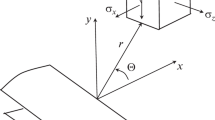Abstract
Based on the classical plate theory in conjunction with the assumption of line contact at the compressive edge of a crack face, closed form solutions were presented for a through-the-thickness central crack in an infinite plate subjected to all around bending. The complete solutions were obtained by superposing the membrane components due to the contact forces at the crack face to the non-closure bending components. The distribution of the contact forces was found uniform by considering the contact condition which prevents mutual penetration of the crack faces at the compressive edges. The results showed that the closure of the crack faces tends to reduce the crack opening displacement at the tension side and, consequently, reduce the stress intensity factor. The finite element method was also used to investigate the present problem. The modified crack closure method in combination with the finite element method was used to find the stress intensity factors. Close agreement between the finite element and the analytical solutions was observed.
Similar content being viewed by others
References
M.L. Williams, Journal of Applied Mechanics 28 (1961) 78–82.
G.C. Sih, P.C. Paris and F. Erdogan, Journal of Applied Mechanics 29 (1962) 306–312.
F. Erdogan, O. Tuncel and P.C. Paris, Journal of Basic Engineering 84 (1962) 542–546.
W.K. Wilson and D.G. Thompson, Engineering Fracture Mechanics 3 (1971) 97–102.
J. Ahmad and T.C. Loo, Engineering Fracture Mechanics 11 (1979) 661–673.
J.K. Knowles and N.M. Wang, Journal of Mathematics and Physics 39 (1960) 223–236.
R.J. Hartranft and G.C. Sih, Journal of Mathematics and Physics 47 (1968) 276–291.
N.M. Wang, Journal of Mathematics and Physics 47 (1968) 371–390.
R.H. Wynn and C.W. Smith, Journal of Basic Engineering 91 (1969) 841–849.
N.M. Wang, International Journal of Fracture Mechanics 6 (1970) 367–378.
R.J. Hartranft and G.C. Sih, International Journal of Engineering Science 8 (1970) 711–729.
G. Yagawa and T. Nishioka, International Journal for Numerical Methods in Engineering 14 (1979) 727–740.
M.V.V. Murthy, K.N. Raju and S. Viswanath, International Journal of Fracture 17 (1981) 537–552.
N.N. Wahba, International Journal of Fracture 27 (1985) 3–30.
S. Viswanath and M.V.V. Murthy, Engineering Fracture Mechanics 32 (1989) 91–109.
S. Viswanath, H.V. Lakshminarayana and D.D. Ravindranath, International Journal of Fracture 41 (1989) R45-R50.
D.P. Jones and J.L. Swedlow, International Journal of Fracture 11 (1975) 897–914.
F.S. HemingJr., International Journal of Fracture 16 (1980) 289–304.
R.S. Alwar and K.N. Ramachandran Nambissan, Engineering Fracture Mechanics 17 (1983) 323–333.
M.J. Young and C.T. Sun. to be published.
E.F. Rybicki and M.F. Kanninen, Engineering Fracture Mechanics 9 (1977) 931–938.
Y.Y. Yu, in Proceedings of the Second U.S. National Congress of Applied Mechanics (1954) 381–387.
P.F. Joseph and F. Erdogan, International Journal of Fracture 41 (1989) 105–131.
T.Y. Yang, Finite Element Structural Analysis, Prentice-Hall, Englewood Cliffs, New Jersey (1986).
Author information
Authors and Affiliations
Rights and permissions
About this article
Cite this article
Young, M.J., Sun, C.T. Influence of crack closure on the stress intensity factor in bending plates — A classical plate solution. Int J Fract 55, 81–93 (1992). https://doi.org/10.1007/BF00018034
Received:
Accepted:
Issue Date:
DOI: https://doi.org/10.1007/BF00018034




